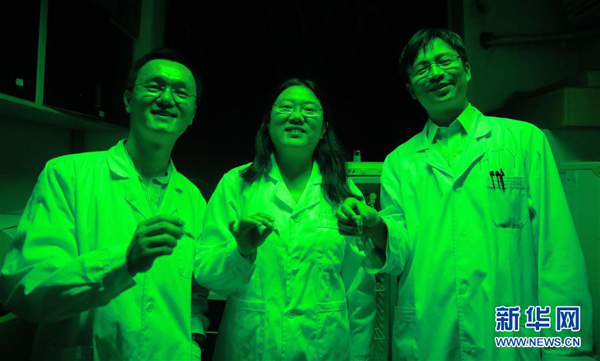


Research team members Liu Zhenfeng, Li Mei and Zhang Xinzheng (from left to right) hold the sample of the super membrane protein in the sample preparation lab of the Institute of Biophysics of the Chinese Academy of Sciences on May 20. (Photo/Xinhua)
A research team from the Institute of Biophysics of the Chinese Academy of Sciences has made a breakthrough in the study of photosynthesis. They are the first to resolve the high-resolution, three-dimensional structure of the super complex in the photosynthesis of spinach. The study has been published in the latest issue of the journal Nature.
This new finding will shine light on many problems relating to energy, food and the environment. In recent years, structural biological research on the photosynthesis of cyanobacteria, algae and other advanced plants has made a great deal of progress. However, structural research on the photosystem II protein complex has lagged behind. The super complex structure was also one of the biggest remaining unknowns in photosynthesis research.
After years of effort, the research team managed to solve the three-dimensional structure by using single-particle, cryo-electronic microscopy technology.
 French girl ties the knot with Chinese boy
French girl ties the knot with Chinese boy Beijing Style: ready for bare legs
Beijing Style: ready for bare legs Century-old station sees railyway evolution
Century-old station sees railyway evolution Enthusiasts perform Kung Fu at Wudang Mountain
Enthusiasts perform Kung Fu at Wudang Mountain Stunning photos of China's fighter jets in drill
Stunning photos of China's fighter jets in drill Monk's mummified body to be made into a gold Buddha statue
Monk's mummified body to be made into a gold Buddha statue Former Chinese solider of the French Foreign Legion seeks wife online
Former Chinese solider of the French Foreign Legion seeks wife online Asia's longest and highest suspension bridge to open to traffic
Asia's longest and highest suspension bridge to open to traffic China's first interactive robot looks like a beauty
China's first interactive robot looks like a beauty Top 20 hottest women in the world in 2014
Top 20 hottest women in the world in 2014 Top 10 hardest languages to learn
Top 10 hardest languages to learn 10 Chinese female stars with most beautiful faces
10 Chinese female stars with most beautiful faces China’s Top 10 Unique Bridges, Highways and Roads
China’s Top 10 Unique Bridges, Highways and Roads Hong Kong opposition should seize the moment
Hong Kong opposition should seize the moment Trump’s anti-immigrant rhetoric strikes a chord with Chinese Americans
Trump’s anti-immigrant rhetoric strikes a chord with Chinese Americans China rejects latest US steel measures
China rejects latest US steel measures Is the wage gap between expats and locals a function of the market – or plain old discrimination?
Is the wage gap between expats and locals a function of the market – or plain old discrimination?Day|Week